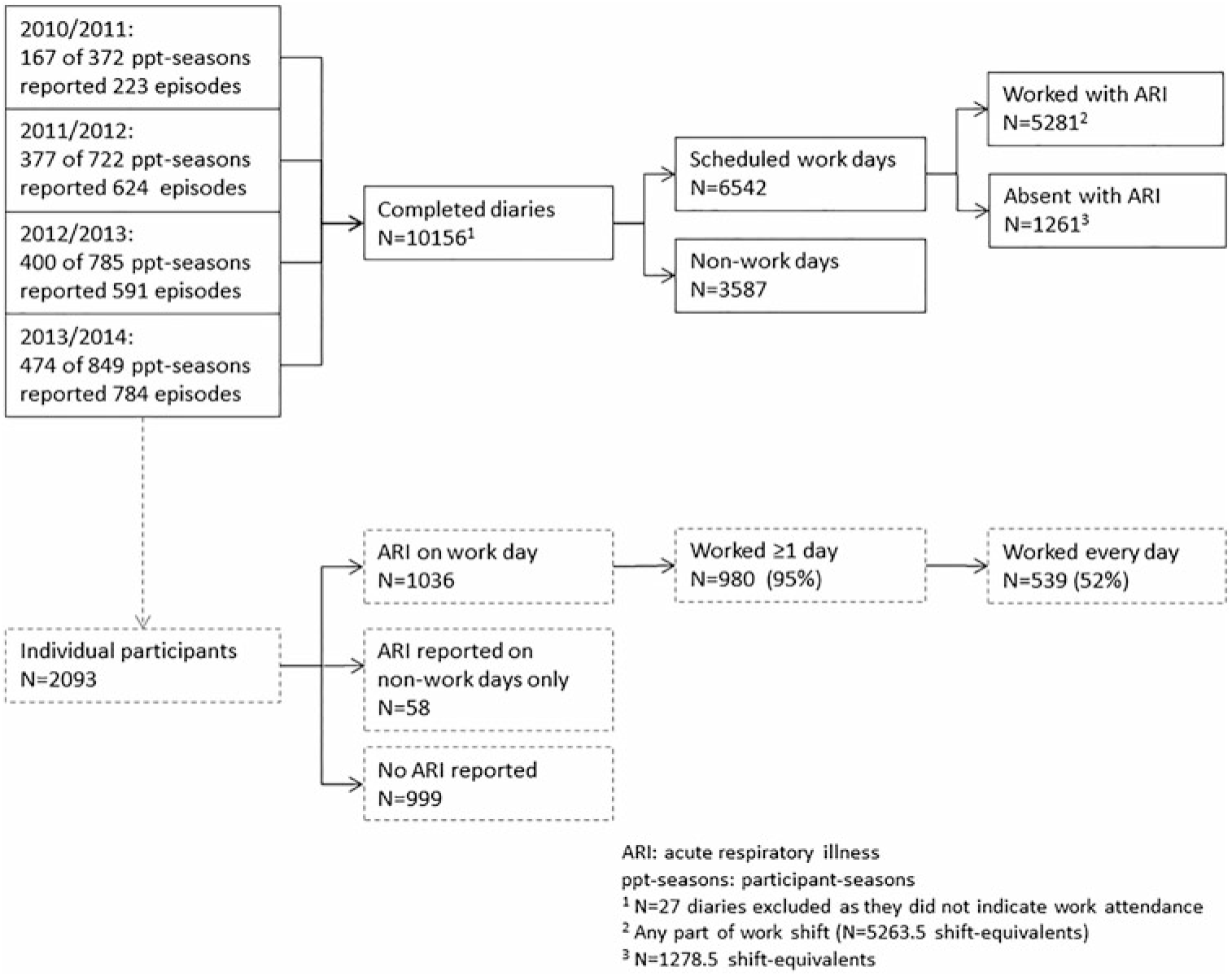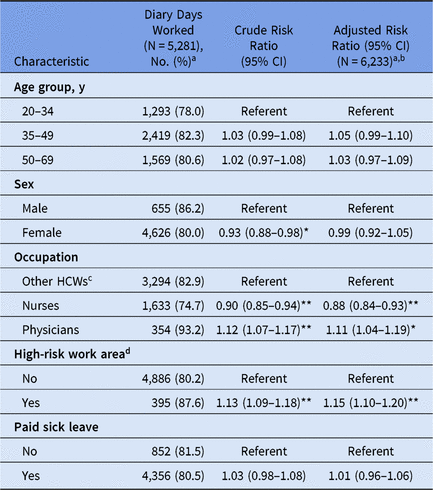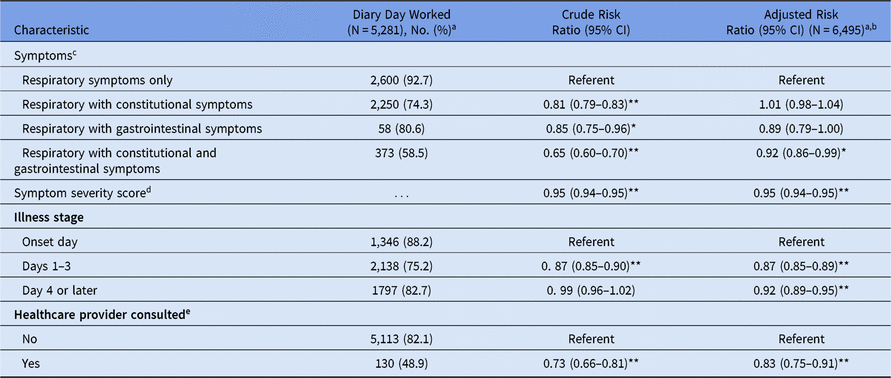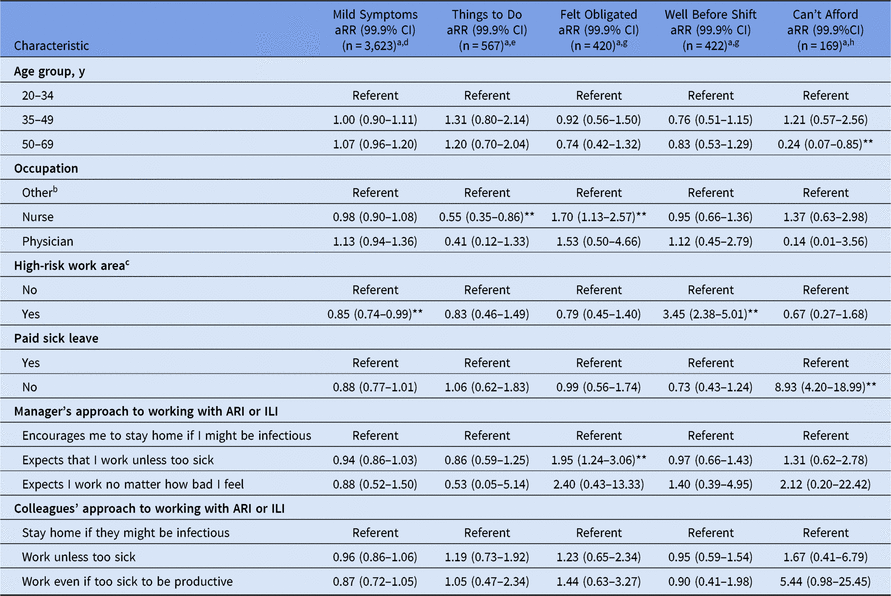Acute respiratory viral illnesses are common and are associated with a substantial burden of mortality, morbidity, and lost productivity. Advances in diagnostic technology have led to increasing recognition of the contribution of respiratory viruses to healthcare-associated infections.Reference Aitken and Jeffries1, Reference Hong, Hong and Ko2 Outbreaks have been reported in many healthcare settings,Reference Horcajada, Pumarola and Martínez3–Reference James, Vernon and Jones8 and hospital-acquired respiratory viral infections are recognized as causing significant mortality and morbidity and increased costs.Reference Hall9, Reference Rao and Nyquist10
Healthcare workers (HCWs) are at occupational risk of respiratory infection, but they can also spread infections to patients and other HCWs.Reference Eibach, Casalegno and Bouscambert11–Reference Huttunen and Syrjänen14 To avoid transmission of viruses causing acute respiratory illness (ARI) in healthcare settings, the Centers for Disease Control and Prevention in the United States recommends that HCWs with fever and respiratory symptoms consider temporary reassignment or exclusion from work for 7 days from symptom onset or until the resolution of symptoms.15 Despite such recommendations, working with symptoms of an ARI is common, with as many as 92% of HCWs reporting to work while symptomatic.Reference Esbenshade, Edwards and Esbenshade16–Reference Mossad, Deshpande, Schramm, Liu and Rothberg18
During a large prospective cohort study of influenza and other respiratory illnesses conducted in 9 hospitals in 3 Canadian cities, we collected information regarding HCW attendance at work during episodes of ARI. This analysis assesses the incidence of working during an ARI, personal attributes and illness characteristics associated with working while ill, and the reasons given for working while ill.
Methods
Data source
These data were collected as part of a 4-season prospective cohort study designed to examine the incidence of and risk factors for influenza among Canadian workers. The study was approved by the research ethics boards of all participating hospitals and universities and by the human resource departments of participating employers. This analysis is restricted to adults (18–69 years old) working in acute-care hospitals. Participants were recruited prior to the start of each influenza season from 9 Canadian hospitals located in Toronto, Ontario (2010–2011 to 2013–2014), Hamilton, Ontario (2011–2012 to 2013–2014), and Halifax, Nova Scotia (2011–2012 to 2013–2014). HCWs were eligible if they worked >20 hours per week. Participants were permitted to enroll in multiple seasons. Following enrollment, participants completed a web-based questionnaire to collect demographics, influenza vaccination history, underlying medical conditions, and work- and community-related risk factors potentially associated with developing a respiratory illness.
Participants completed daily online illness diaries whenever they developed symptoms potentially compatible with an ARI (ie, fever without another obvious source or any respiratory symptom including runny or stuffy nose, sneezing, sore or scratchy throat, hoarseness, or cough). Diaries were completed daily for at least 3 days or until all symptoms were either absent or mild, whichever was longer. Illness diaries collected information about presenting symptoms, possible exposures, attendance at work, reason for work or absence, and medical consultations. For these analyses, diaries were eligible if they belonged to an illness episode that included at least 1 of the following symptoms: shortness of breath, cough, sore or scratchy throat, or coryza (ie, an ARI).19
Definitions
Each influenza season was defined as the first Monday following the week in which the percentage of specimens testing positive for influenza was ≥5% until the first Monday after the percentage testing positive was below 3% for 2 consecutive weeks. A participant season was defined as 1 individual participating for the entire influenza season. For those who withdrew, participant-season contributions were calculated as the percentage of days they participated during the season.
The outcome for the analysis of personal attributes and illness characteristics associated with working with symptoms of an ARI was work attendance or absence while symptomatic with an ARI on a scheduled work day. For the analysis of factors associated with the reasons for working with respiratory symptoms, the outcome was 1 of 5 reasons for working while symptomatic with an ARI on a scheduled work day. Reasons for working were (1) symptoms were mild and felt well enough to work, (2) felt miserable but had work that needed to be done, (3) felt miserable but felt obligated to work, (4) felt well when left home for work, (5) could not afford to stay home. Open-ended responses that did not fit into 1 of these 5 classifications were grouped as ‘other.’ Occupation was categorized as physician, nurse, and other HCW (ie, other healthcare professionals and administrative, research, and support staff). A high-risk work area was defined as an emergency department, intensive care unit, or medical inpatient unit. Manager’s and colleagues’ approaches regarding ARI sick leave included: (1) stay home if illness might be infectious, (2) work unless too sick to work, and (3) work no matter how bad the illness is.
Healthcare provider consultation included consultations with a physician or nurse practitioner, with occupational health clinic staff, or with a registered nurse by telephone (ie, Telehealth in Ontario or 811 in Nova Scotia). Symptoms were categorized as (1) respiratory (runny and/or stuffy nose and/or sinus pain, sore or scratchy throat, hoarseness, cough, or shortness of breath), (2) constitutional (fever (≥37.8°C), headache, chills, generalized muscle pain or new onset joint pain), or (3) gastrointestinal (nausea, vomiting, or diarrhea). Each symptom was scored on a 4-point scale: absent (0), mild (1), moderate (2), or severe (3). The symptom severity score was the sum of the 10 respiratory and constitutional symptom scores.Reference Whitley, Boucher and Lina20 Illness diaries were categorized into 3 periods based on illness onset: day of illness onset (day 0), days 1–3, or days ≥4.
Data analysis
The overall seasonal incidence of working with symptoms of an ARI (or absence from work) was estimated using the total number of working (or absent) days scheduled to work while symptomatic divided by the total participant seasons. Participants who worked for a partial day were classified as working 0.5 day. People who chose to and were able to work from home were classified as working and were included in subsequent analyses.
All multivariable analyses were conducted using Poisson regression models with robust variance estimation and generalized estimating equation (GEE). GEE was used to account for the dependency of multiple illness diaries reported by a participant for a single episode and, as required, for multiple seasons of participation and/or multiple ARI episodes per season. Spearman correlation was used to assess associations between pairs of factors before multivariable regression. If correlation coefficients were >0.7, only 1 factor with the related concept was retained based on the quasi-likelihood under the independence model criterion (QIC).Reference Midi, Sarkar and Rana21, Reference Pan22 Potential confounding and mediation were assessed and adjusted for using multivariable regression modeling where all the factors were entered simultaneously.Reference Ranganathan, Pramesh and Aggarwal23
To assess the impact of personal attributes on participants’ work attendance during an ARI, we evaluated the following covariates: age, sex, years of work experience, occupation, hospital, work area, whether entitled to paid sick leave, and manager’s and colleagues’ approaches regarding ARI sick leave. Potential confounding variables assessed were study season, chronic medical conditions, multiple seasons of participation, and vaccination status for the current season. The significant personal attributes and those considered biologically important were then used to adjust the estimates of association between the characteristics of the illness and working while symptomatic with an ARI. The variables in the characteristics of illness model included the types of ARI symptoms, symptom severity, illness stage, and healthcare provider consultation. Body temperature was not reported on most illness diaries, resulting in numerous missing values. A sensitivity analysis assuming that all illness diaries with a missing value for fever indicated “no fever” was conducted to evaluate the impact of fever on working while ill.
To assess the relationship between the participants’ personal and work characteristics and the reasons for working while symptomatic with an ARI, 5 separate GEE Poisson regression models with robust error variance were fitted. Each of the 5 reasons for working while symptomatic was compared to all other reasons. To account for multiple testing, the significance level was set at P < .001.
Sensitivity analyses were conducted to assess the impact of using all individual participants in each analysis compared with choosing their first season of participation only. Two-tailed tests were used, and associations with P < .05 were considered statically significant unless otherwise noted. All analyses were conducted using Stata version 11 software (StataCorp, College Station, TX).
Results
Over 4 influenza seasons from 2010–2011 to 2013–2014, 2,093 HCWs participated in the study, and 498 (23.8%) participated for multiple seasons: 323 (15.4%) participated for 2 seasons, 125 (6.0%) participated for 3 seasons, and 50 (2.4%) participated for 4 seasons (equaling 2,728 participant seasons and referred to as participants henceforth). As shown in Table 1, the median age of the HCWs was 41.5 years (range, 21–69); 1,784 (85%) were female; 1,142 (55%) had >9 years of work experience;79% were entitled to paid sick leave; 193 (9%) reported asthma in the past 12 months; and 6% had a chronic medical condition. Participants who contributed to multiple seasons were older, had worked for more years, and were not recruited in the final year of the study while they were less likely to be nurses and were more likely to work in high-risk areas (Table 1).
Table 1. Description of Participant Characteristics by Number of Seasons Enrolled in Study, Canadian Acute-Care Hospital Staff, 2010–2011 to 2013–2014

Note. HCW, healthcare worker.
a Because of missing data, some totals are <2,093.
b Includes nonphysician and nonnursing healthcare professionals, support, and administrative staff.
c Worked in an emergency department, intensive care unit, or medical inpatient unit.
d Diagnosed with asthma and had symptoms and/or had taken medicine for asthma in past year.
e Diabetes, heart disease, or other immunodeficiency condition.
Over the 4 studied seasons, 2,222 ARI episodes (by 2,728 participants) were reported, which is equivalent to an incidence of 0.81 (95% confidence interval (CI) 0.80–0.83) ARI episodes per participant. As shown in Figure 1, at least 1 ARI was reported by 50.4% of participants (ranging from 44.7% to 52.7% per season). The percentage of participants reporting an illness episode was higher for those with multiple seasons’ contributions than for those who only participated for a single season (59.7% vs 43.2%; P < .001). Among the 1,036 participants with ARI symptoms occurring on a scheduled work day, 539 (52.0%) reported working on every scheduled day whereas 980 (94.6%) reported working at least 1 day.

Fig. 1. Participant flow chart.
In total, 10,156 illness diaries were completed by 2,728 participants, with a mean of 3.7 diaries (95% CI, 3.7–3.8) per participant. Diaries of participants not scheduled to work (3,587 or 35%) were excluded from further analyses. Among the remaining 6,542 illness dairies, participants worked on 5,281 days, for to a mean of 1.93 days (95% CI, 1.91–1.95) worked with an ARI and 0.47 days (95% CI, 0.45–0.49) of absence per ARI per participant.
In our multivariable analysis (Table 2), the adjusted relative risk (aRR) of working during ARI episodes was higher for physicians (aRR, 1.11; 95% CI, 1.04–1.19) and lower for nurses (aRR = 0.88; 95% CI, 0.84–0.93) than for other HCWs. Participants who worked in high-risk work areas were more likely to work while symptomatic (aRR, 1.15; 95% CI, 1.10–1.20) than those from other hospital areas. As shown in Table 3, participants were less likely to work as symptom severity scores increased (aRR, 0.95 per 1-point increase; 95% CI, 0.94–0.95), if respiratory symptoms were accompanied by constitutional and/or gastrointestinal symptoms (aRR, 0.92; 95% CI, 0.86–0.99), and on the days subsequent to illness onset (aRR, 0.87; 95% CI, 0.85–0.89). In a sensitivity analysis (see Supplementary Table S1 online), participants who reported a fever were less likely to work (aRR, 0.84; 95% CI, 0.72–0.98) than those assumed to have no fever, even after adjusting for other covariates in the original model.
Table 2. Healthcare Worker (HCW) Attributes Associated With Working on Scheduled Work Days While Symptomatic With an Acute Respiratory Illness, Canada 2010–2011 Through 2013–2014

Note. CI, confidence interval. *P < .05; **P < .001.
a Of 6,542 illness diaries submitted for scheduled work days (data missing for some covariates).
b Adjusted for the variables included in column, hospital site, asthma in the past 12 months, chronic medical conditions, study season, multiple seasons’ participations, manager’s and colleagues’ approach to ARI and ILI, and influenza vaccination status. In unadjusted or adjusted analysis, there was no association between working while ill and hospital site, or presence of chronic medical conditions (data not shown).
c Includes nonphysician and nonnursing healthcare professionals, support staff, and administrative staff.
d Worked in an emergency department, intensive care unit, or medical inpatient unit.
Table 3. Illness Characteristics Associated With Healthcare Workers (HCWs) Working During Episodes of Acute Respiratory Illness, Canada, 2010–2011 Through 2013–2014

Note. CI, confidence interval. *P < .05; **P < .001.
a Of 6,542 illness diaries submitted for scheduled work days (data missing for some covariates).
b Adjusted for the variables included in column, study season, hospital, age, sex, occupation and work area.
c Respiratory: runny or stuffy nose, sore or scratchy throat, hoarseness, cough, or shortness of breath. Gastrointestinal: nausea, vomiting or diarrhoea. Constitutional: fever, headache, chills, muscle pain or joint pain.
d Sum of 10 respiratory and constitutional symptoms’ ratings; 4-point scale (0–3 for absent to severe).
e Consulted with physician, nurse practitioner, occupational health nurse or physician, or Telehealth nurse.
Of the 5,281 completed illness diaries, the reasons for working during an ARI were “symptoms were mild and felt well enough to work” (n = 3,623 or 69%), “felt miserable but had things I had to do” (n = 567 or 11%), “felt miserable but felt obligated to work” (n = 420 or 8%), “felt well when I left home” (n = 422 or 8%), and “could not afford to stay home” (n = 169 or 3%). Of the 80 free-text responses, 32 (40%) were because the HCW worked from home. As shown in Table 4, nurses were significantly less likely than other HCWs to choose the response “felt miserable but had things I had to do” (aRR, 0.55; 99.9% CI, 0.35–0.86). However, nurses and those who perceived that their managers expected them to work “unless they were too sick” were more likely to state feeling “obligated” to work (aRR, 1.70; 99.9% CI, 1.13–2.57 and aRR, 1.95; 99.9% CI, 1.24–3.06, respectively). Although participants who worked in high-risk areas were less likely to say they worked because symptoms were mild (aRR, 0.85; 99.9% CI, 0.74–0.99), they were more likely to report that they worked because the illness started during the work day (aRR, 3.45; 99.9% CI, 2.38–5.01). Participants without paid sick leave benefits were significantly more likely to state that they worked because they could not afford to stay home (aRR, 8.93; 99.9% CI, 4.20–19.0), whereas older HCWs (50–69 years) were less likely to choose this as a reason (aRR, 0.24; 99.9% CI, 0.07–0.85). The sensitivity analysis found no difference in the covariates included, nor substantive differences in the estimates, when comparing all participants with only the first season of participation.
Table 4. Associations Between Healthcare Worker (HCW) Attributes and Their Stated Reasons for Attending Work on Scheduled Work Days When They Had Symptoms of an Acute Respiratory Illness, Canada 2010–2011 Through 2013–2014

Note. ARI, acute respiratory illness; CI, confidence interval; ILI, influenza-like illness; aRR, adjusted relative risk. **P < .001 (significance set at <.001 to adjust for multiple testing).
a Adjusted for variables in column, sex, asthma in the past 12 months, chronic health condition, multiple seasons’ participations, province (Ontario or Nova Scotia), and influenza vaccination status: each reason was compared separately with all others combined.
b Nonnursing and nonphysician including other professionals, support, and administrative personnel.
c Emergency department, intensive care unit, or medical inpatient unit.
d Symptoms were mild and felt well enough to go.
e Felt miserable but had things to do.
f Felt miserable but felt obligated to work.
g Felt well when I left home.
h Could not afford to stay home.
Discussion
In this 4-season prospective cohort study, we found that 50% of participants working in Canadian acute care hospitals reported episodes of ARI during each influenza season, with 95% of those who reported an ARI working 1 or more days of their illness. HCWs in our study reported working for a mean of 1.9 days with symptoms of an ARI and took an average of 0.5 days of sick leave during an ARI each influenza season.
Our findings regarding working during episodes of ARI mirror those of retrospective studies in which 21%–36% of HCWs reported influenza-like illnesses (ILIs) or respiratory infections during the influenza season: 86%–92% reported working at least 1 day, and 41%–52% reported working for 3 or more days.Reference LaVela, Goldstein, Smith and Weaver17, Reference Mossad, Deshpande, Schramm, Liu and Rothberg18, Reference Chiu, Black and Yue24 These findings, and the facts that (1) HCWs in our study were more likely to work on the first day of illness (when viral shedding and risk of transmission are higher)Reference Lau, Cowling and Fang25, Reference Walsh, Peterson, Kalkanoglu, Lee and Falsey26 and (2) HCWs working in high-risk areas were more likely to work during an ARI, emphasize the need to be concerned about the risk of transmission to vulnerable patients. HCWs, managers, workplace health and safety and infection control staff, and administrators should be educated about the risk of transmission associated with respiratory viral infection and to clarify what symptoms require exclusion from work.Reference Tanksley, Wolfson and Arora27 Staff in hospitals that issued work restrictions to exclude HCWs with symptoms of infection or that instituted mandatory absence from work for 7 days during episodes of laboratory-confirmed influenza were significantly less likely to work while symptomatic with an ARI or ILI.Reference LaVela, Goldstein, Smith and Weaver17, Reference Tanksley, Wolfson and Arora27 Our data provide an estimate of the impact of such policies: HCWs in acute-care settings would miss an average of 2 additional days of work each influenza season. Infection control and occupational health and safety teams need to (1) educate HCWs on the risk of transmission of viruses causing ARIs, (2) improve self-awareness of when the HCWs themselves are higher risk of transmitting to their vulnerable patients, and (3) develop and implement policies for working while symptomatic.28
In our cohort, similar to the findings of Chiu et al,Reference Tanksley, Wolfson and Arora27 the most common reason for working with an ARI (69% of all days were worked) was that symptoms were mild. Although viral shedding correlates with symptom severity in respiratory viral illness, it is not known what proportion of transmission of viral illness is due to asymptomatic or mildly symptomatic disease compared to more severely symptomatic disease. Because administrators can be expected to be concerned about the costs of absenteeism associated with HCWs staying away from work with mild symptoms, better data on the burden of HCW-transmitted illness and the burden to patients and hospitals caused by HCWs working while ill will be needed to justify implementing a practice of HCWs staying home during all episodes of ARI.
Although only 3% of days worked while ill in our cohort were because the HCWs could not afford to stay home, 80% of our participants had paid sick leave. Not being able to afford to lose the pay and/or not having paid sick leave were cited more often by HCWs in the study by Chiu et al,Reference Chiu, Black and Yue24 which was performed in the United States. However, their participants were encouraged to choose all applicable reasons, whereas we asked for only 1 reason. Nonetheless, numerous studies in nonhealthcare settings report significant associations between paid sick leave benefits and working while ill.Reference Bockerman and Laukkanen29–Reference Bierla, Huver and Richard32 Policies that provide pay for HCWs absence during communicable disease illness episodes may help reduce the percentage who work while ill.
Compared to other HCWs, physicians have greater autonomy but are often also less likely to have paid sick leave. The cultural norms regarding “working while sick” may also differ between professions.Reference Szymczak, Smathers, Hoegg, Klieger, Coffin and Sammons33 In our study, similar to that of Mossad et al,Reference Mossad, Deshpande, Schramm, Liu and Rothberg18 physicians were significantly more likely to work while ill than nurses and most other categories of HCWs. Also, 3 other studies that reported nonsignificant differences between physicians and nurses regarding working while ill with ILI were underpowered to identify significant differences.Reference Esbenshade, Edwards and Esbenshade16, Reference Chiu, Black and Yue24, Reference Mitchell, Ogunremi and Astrakianakis34 In 2 of these 3 studies, physicians were more likely to work while ill, but the difference was not statistically significantReference Esbenshade, Edwards and Esbenshade16, Reference Chiu, Black and Yue24 In the third study, data by profession were not provided.Reference Mitchell, Ogunremi and Astrakianakis34 Because physician behavior is influential to other HCWs, attention needs to be given to changing both cultural norms among physicians and developing models of shared coverage to permit continuity of care allowing for physician absence for illness.
Our study has several limitations. Some of the occupations were not proportionally represented in the cohort; physicians and other HCWs were somewhat underrepresented, which affects the generalizability of the results. Influenza vaccination rates were higher in our study population than in partnering hospitals, suggesting that participating HCWs were less likely to become ill with influenza and may have been more likely to adhere to other preventive practices as well. However generalizability was enhanced by the fact that data were collected over 4 influenza seasons from a large sample of HCWs from 9 acute-care hospitals in 3 cities and 2 provinces. Illnesses were self-reported. As such, we cannot assess the proportion of illnesses for which diaries were not submitted or whether there were biases in adherence to the submission of these diaries. In particular, participants were asked to submit a self-collected mid-turbinate nasal swab with every ARI. This protocol may have reduced the number of ARIs reported, resulting in an underestimation of the incidence of illness and absence from work. Similarly, attendance at work was self-reported. Alternatively, participants completed illness diaries in near real time, reducing recall bias, and research staff sent weekly reminders to participants to complete illness diaries and followed up with anyone who sent a swab without completing at least 3 diaries or vice versa.
In summary, our study confirms that working with symptoms of an ARI is common in our hospitals and provides an estimate of the increased rate of absenteeism that would result if no HCWs worked with ARI. Our data also reveal that the greatest contributor to working with ARI is that the illness is perceived as too mild to interfere with work. Reducing the rate of HCWs working with ARI will require changing both sick leave policies and cultural norms. It may also require data that better quantify the risk of transmission associated with HCWs working while ill.
Supplementary material
To view supplementary material for this article, please visit https://doi.org/10.1017/ice.2019.141
Author ORCIDs
Brenda L. Coleman, 0000-0002-7144-4827
Acknowledgments
We offer our sincere appreciation to our dedicated research staff and to all participants for their steadfast commitment to the study. We also wish to acknowledge the contribution of nonauthor members of the Canadian Healthcare Worker Study Group.
Financial support
This work was funding by the Canadian Institutes of Health Research (grant no. 111187) and the Ontario Workplace Safety and Insurance Board (grant no. 10031).
Conflicts of interest
The authors declare that they have no conflicts of interests related to this article.







